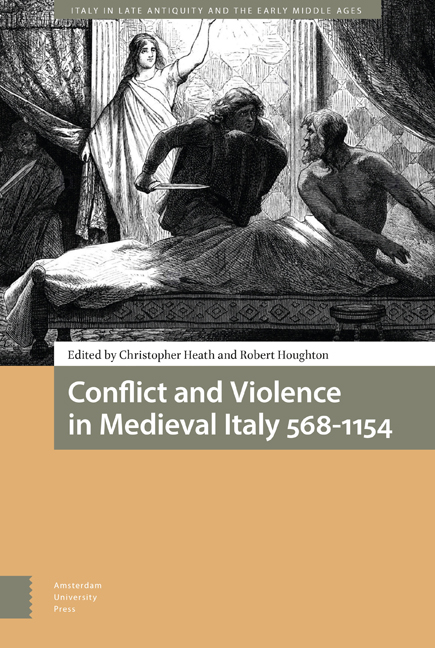Book contents
- Frontmatter
- Table of Contents
- Abbreviations
- Preface
- 1 Introduction: Discordant Minds and Hostile Nations
- 2 Morbidity and Murder: Lombard Kingship’s Violent Uncertainties 568-774
- 3 Insurgency and Counterinsurgency in Lombard Italy (c600-700)
- 4 Troubled Times: Narrating Conquest and Defiance between Charlemagne and Bernard (774-818)
- 5 ‘Nec patiaris populum Domini ab illis divinitus fulminandis Agarenis discerpi’: Handling ‘Saracen’ Violence in Ninth-Century Southern Italy
- 6 Formosus and the ‘Synod of the Corpse’: Tenth Century Rome in History and Memory
- 7 Sex, Denigration and Violence: A Representation of Political Competition between Two Aristocratic Families in Ninth Century Italy
- 8 ‘Italy and her [German] Invaders’: Otto III’s and Frederick Barbarossa’s Early Tours of Italy – Pomp, Generosity and Ferocity
- 9 ‘I Predict a Riot’: What Were the Parmense Rebelling Against in 1037?
- 10 The Strange Case of Deusdedit and Pandulf: Two Accounts of Honorius II’s Election
- Afterword
- Index
Afterword
Published online by Cambridge University Press: 07 September 2022
- Frontmatter
- Table of Contents
- Abbreviations
- Preface
- 1 Introduction: Discordant Minds and Hostile Nations
- 2 Morbidity and Murder: Lombard Kingship’s Violent Uncertainties 568-774
- 3 Insurgency and Counterinsurgency in Lombard Italy (c600-700)
- 4 Troubled Times: Narrating Conquest and Defiance between Charlemagne and Bernard (774-818)
- 5 ‘Nec patiaris populum Domini ab illis divinitus fulminandis Agarenis discerpi’: Handling ‘Saracen’ Violence in Ninth-Century Southern Italy
- 6 Formosus and the ‘Synod of the Corpse’: Tenth Century Rome in History and Memory
- 7 Sex, Denigration and Violence: A Representation of Political Competition between Two Aristocratic Families in Ninth Century Italy
- 8 ‘Italy and her [German] Invaders’: Otto III’s and Frederick Barbarossa’s Early Tours of Italy – Pomp, Generosity and Ferocity
- 9 ‘I Predict a Riot’: What Were the Parmense Rebelling Against in 1037?
- 10 The Strange Case of Deusdedit and Pandulf: Two Accounts of Honorius II’s Election
- Afterword
- Index
Summary
In memory of Shani D’Cruze (1954-2021)
At a conference in June 2018 the geographer James A. Tyner argued for the importance of the idea of violence as a process which comes into being through political practice and suggested that scholars should ‘interrogate critically how individuals and society simultaneously represent and experience violence’. In this short final reflection I will not repeat the points made by the editors in the Introduction or those made by the contributors in their respective chapters. Instead, I offer a few reflections on Tyner's ‘simultaneous experience of violence and its representation’ as approached through the three broad themes of narrative, gender and place which recur throughout this volume. It is hoped that highlighting this way of looking at violence at the end of this book will prompt readers to make connections for themselves between the various essays.
First, some historiographical context is needed. It is no surprise to readers of this book that the so-called ‘Dark Ages’ may have been no more violent than other periods in Italy's past, including the present. If this was so, why did the image of these centuries as a violent age come about? One answer is that many of the surviving narrative sources privileged certain sorts of violent behaviour which now seem remote and even shocking to us. The obvious example is feuding, although we now know that phenomenon was less prevalent, less brutal and rather more complex than has often been supposed, even in Italy. Even so this volume certainly shows that very many episodes of political disarray can be found in earlier medieval Italian history, well-documented in diverse written genres as the Introduction outlines. Typically, texts reported violent actions which arose out of disputes over political control both because of their own interest in that violence and its consequences but also to make moral or other points for the benefit of readers, usually by presenting violence as the just result of the actions of God in the world. Another myth is that this period is always poorly documented, but as the chapters taken together make absolutely clear, the amount of evidence is considerable.
- Type
- Chapter
- Information
- Conflict and Violence in Medieval Italy 568-1154 , pp. 325 - 336Publisher: Amsterdam University PressPrint publication year: 2021



